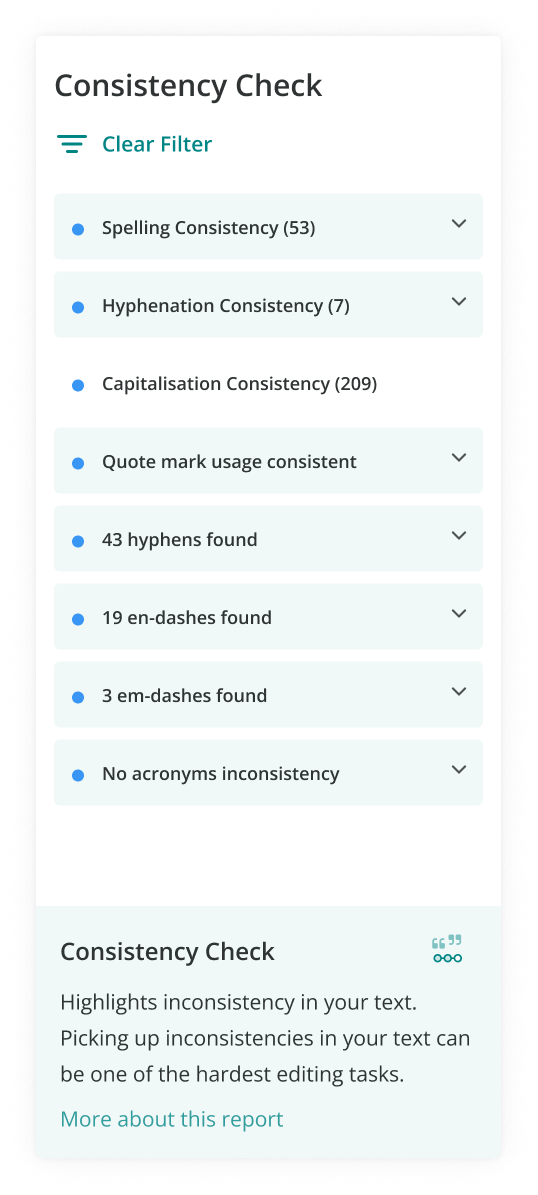
Writing dates can be confusing. Where do the commas go? What if you need to include the day of the week?
Today, we’re teaching you how to write the date correctly every time.
Most of this article will focus on the American date format, but we will cover the differences between British and American English date formats, too.
How to Write Dates
One reason writing dates is so confusing is that there are so many options.
How to write the date varies based on geography, the circumstance, such as how formal you need to be, whether you need the year, and whether you’re using purely numerical forms.
We’ve broken down the different date formats, so you know how to write the date in every situation.
Month-Day-Year
The month-day-year date is the most common format used in America.
When you need to write the entire date, place a comma after the day. Here’s what it looks like:
- July 4, 1776
When we see the date, we read the day in our heads, or out loud, as ordinal numbers. However, it’s not necessary to actually use ordinal numbers (e.g. 4th) when you write the day.
When you write the month-day-year format in the middle of a sentence, place another comma after the year.
- America was founded on July 4, 1776, when the Founding Fathers signed the Declaration of Independence.
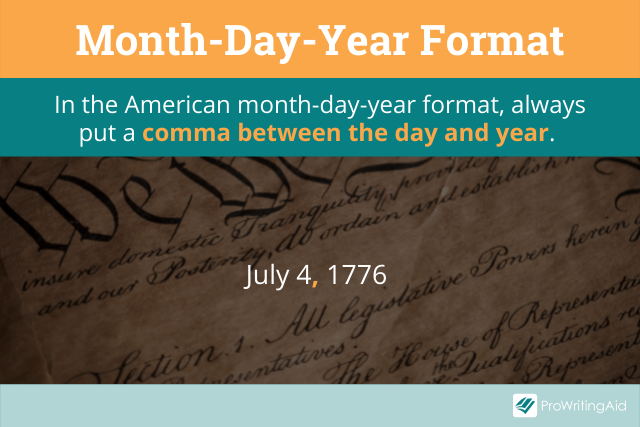
Month-Day
Writing just the month and day is simple. Just leave off the comma and the year.
- July 4
When you write the month-day format in the middle of a sentence, only place a comma after the day if the date ends a dependent clause or introductory phrase. Never place a comma after the month.
- We go every July 4 to see fireworks.
- Because it’s July 4, we are going to see fireworks.
Just like when you include the year, there’s no need to write the ordinal number form of the day.
The only time the date should include an ordinal number is when the format is inverted and the word “of” is included. Here’s an example from a famous folk song:
- I’m a Yankee Doodle Dandy! Yankee Doodle do-or-die. A real live nephew of my Uncle Sam, born on the 4th of July.
In this form, you can use numeric or word formats for the ordinal numbers: 4th or fourth.
Month-Year

Sometimes, we only need to write dates with the month and year. We might refer to a general time frame, or we may not know the exact date of something.
As with other date formats, don’t include a comma between the month and year. Only place a comma after the year if the date ends a dependent clause or introductory phrase.
Let’s look at a few examples of how to write the month and year.
- June 2022
- Her baby is due in June 2022.
- In June 2022, she will have her baby.
With the Day of the Week
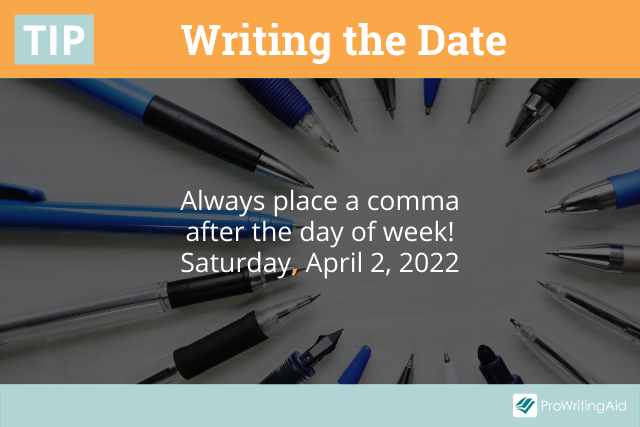
When writing dates with the day of the week, always place a comma between the day of the week and the rest of the date. Then, follow the above rules for the rest of the date.
This is one type of date format where the comma rule is the same for British English: you always put a comma after the day of the week.
Here are some examples of how to write the date with the day of the week. Please note these examples are using the American date format.
- Saturday, April 2, 2022
- The wedding is Saturday, April 2, 2022.
- The wedding takes place Saturday, April 2, 2022, at the Bellagio Chapel in Vegas.
Numerical Forms
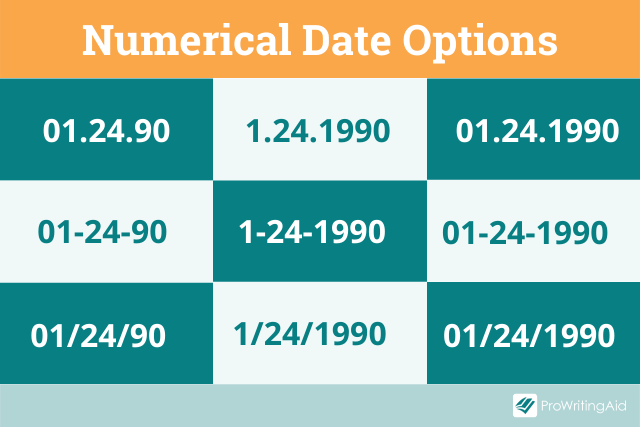
We don’t always write dates by spelling out the month. Often, we use an all-numeric date format, such as when we sign a form, take notes, or write in a diary.
Typically, we don’t use the purely numerical form when writing the date in a sentence. In those situations, use the rules above and spell out the month.
When you do write the date with just numbers, there are a few ways you can format it. However, you should always use the month-day-year format for American English.
There are a few accepted punctuation marks for numeric dates: hyphens, slashes, and periods. In American dates, hyphens and slashes are the most common.
It’s also acceptable to omit the zero in the month or day, if the number is less than 10. However, some online forms will require you to use a zero.
You can use either four digits or two digits for the year. Only use two-digit numbers if it’s clear which century you’re talking about.
If it’s a birthdate of a living person, we can deduce whether the year occurred in the 1900s or 2000s.
Now, let’s take a look at several ways we might write the same date in the numerical format.
- 01-24-1990
- 1-24-90
- 01/24/90
- 1/24/1990
- 01.24.90
- 1.24.1990
Selecting one of these date formats is usually a matter of personal preference, although if you have a style guide for your writing, defer to its formatting.
The important thing is to be consistent with whichever format you choose.
Years, Decades, and Centuries
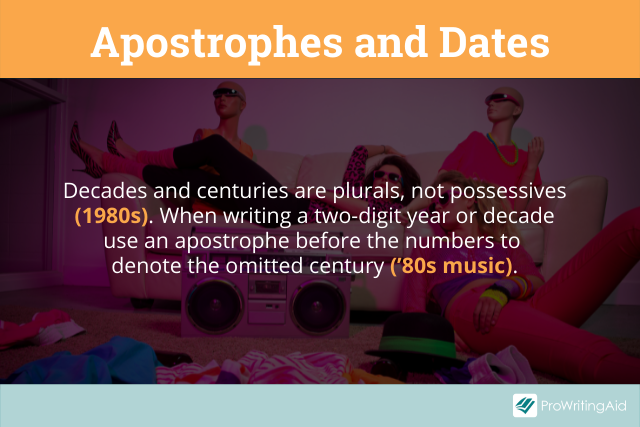
Years, decades, and centuries can be confusing to write. Let’s look at each type in more detail.
When we write the year, we typically use a four-digit format.
We saw in the previous section that we can use a two-digit year in the numeric form. Both four digits and two digits are correct and are a matter of personal preference.
But sometimes we reference a year in a sentence and only use two-digits. In this case, we place an apostrophe before the digits. The apostrophe replaces the century of a four-digit year.
- I bought a ’69 Camaro.
We don’t always use a two-digit format in a sentence. You could say, “I bought a 1969 Camaro.” But when you choose to use only two-digits in a sentence, the apostrophe is required.
Remember, the apostrophe is not required when you write an entire, exact date in numerical form.
When we write years out in long form, you can include “and” after “thousand,” or you can omit it. American English tends to omit the “and,” but it's correct either way.
- Correct: Two thousand eight was when I graduated high school.
- Correct: Two thousand and eight was when I graduated high school.
Apostrophe rules get tricky when we write decades. When we reference a decade, the rules for writing plurals apply: never use apostrophes for plural words. For decades, never put an apostrophe between the decade and the /s/.
- Incorrect: I love listening to the hair bands of the 1980’s.
- Correct: I love listening to the hair bands of the 1980s.
If you omit the first two digits, place an apostrophe before the decade number. You still shouldn’t put an apostrophe before the /s/.
- Incorrect: I love listening to the hair bands of the 80’s.
- Incorrect: I love listening to the hair bands of the ’80’s.
- Correct: I love listening to the hair bands of the ’80s.
You can also write the decade in word form, e.g. “eighties.”
Similarly to decades, if you reference a century in a four-digit format, do not place an apostrophe before the /s/.
- Incorrect: I love the fashion of 1700’s.
- Correct: I love the fashion of the 1700s.
Adding an apostrophe to plurals is a common writing error. ProWritingAid will point out unnecessary apostrophes in your plural numbers.
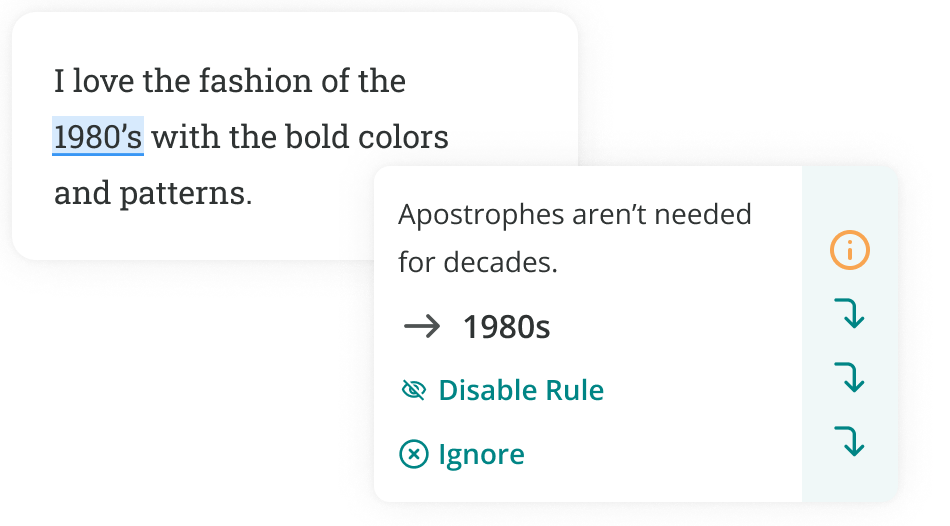
When you write centuries in the ordinal form, add the correct suffix after the number or use the word format. There’s no need to capitalize the word form.
- Correct: I love 18th-century fashion.
- Correct: I love eighteenth-century fashion.
Correct Date Format in British English

British English uses a different date format in which the month and day are inverted (day-month-year). In British English, dates do not need commas before or after the year, even in a sentence.
- 11 November 1918
- Armistice Day on 11 November 1918 marked the end of World War I.
The inverted format also applies to numeric dates, e.g. 14/2/2017.
How to Write the Date and Time in a Sentence
We’ve seen several examples of how to write the date in a sentence. Writing the time in a sentence is simple.
You can write the time in a sentence as hour:minute plus a.m. or p.m. If you’re using a 24-hour time format, the a.m. or p.m. is not required.
You can also leave it off if it’s clear what time of day something occurs. Here’s what this looks like:
- I get out of school at 3:45 p.m.
- I get out of school at 3:45. (The p.m. is not necessary because we can assume you don’t get out of school at 3:45 a.m.)
- I get out of school at 15:45.
If the time that you’re writing occurs on the hour, you can also write “o’clock.” Instead of a.m. or p.m., describe the time of day if necessary.
- He will be there at four o’clock.
- He will be there at four o’clock in the afternoon.
If you need to write both the time and date, just combine the rules. Here are two examples:
- My flight arrives on December 13 at 10:40 a.m.
- Your appointment is at 2 o’clock on February 27, 2022.
Write Dates Consistently
There are many ways to write a date, but it’s important to use the same format consistently throughout your writing.
ProWritingAid’s Consistency Report can check for consistent mechanics, like dates, punctuation, spelling variations, and more.
